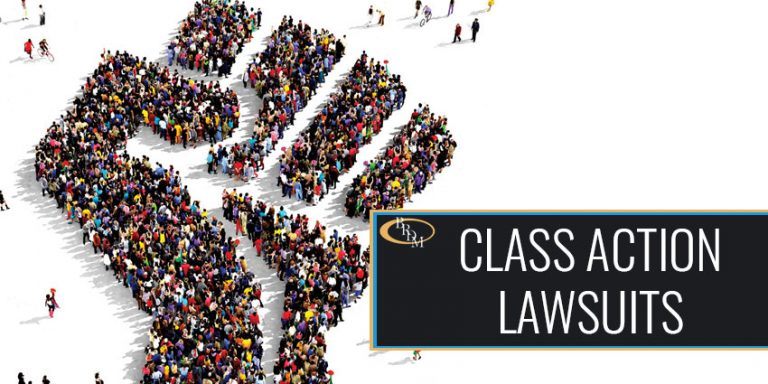Recognizing the Archer-Daniels-Midland Class Action Lawsuit: Key Insights
Wiki Article
Exploring Course Action Claims: What You Required to Know
Course action suits have become significantly widespread in today's legal landscape, with individuals joining forces to prosecute versus organizations and corporations. In this discussion, we will certainly check out the ins and outs of class activity claims, losing light on their meaning, the needs for filing, and the prospective advantages and disadvantages included. Moreover, we will certainly explore the actions involved in a course action suit and analyze some recent spots situations that have formed this location of law. Comprehending the complexities and subtleties of class action lawsuits is important for anyone looking for justice in a collective fashion, so let's begin our expedition together.The Definition of Course Activity Lawsuits
A course action claim is a legal action filed by a team of people who have similar claims against an offender. Course activity lawsuits are usually brought when the number of prospective plaintiffs is too huge for specific claims to be functional.One of the crucial elements of a course activity claim is that the lead plaintiff, likewise understood as the class agent, represents the interests of all the course members. The court appoints the lead plaintiff based on their capacity to relatively and effectively represent the class. The lead complainant works closely with the course action lawyer to look for and build a strong case settlement or various other remedies on behalf of the whole course.
In order for a course action claim to proceed, the court has to accredit the class. This indicates that the court determines that the legal action satisfies certain demands, such as numerosity (a huge enough number of class members), commonality (typical concerns of law or truth), typicality (the claims of the lead complainant are normal of the class), and competence of representation (the lead plaintiff and course guidance can representing the class's rate of interests) As soon as the class is licensed, the lawsuit can progress, and any kind of judgment or negotiation reached will apply to all course members unless they select to opt-out.
Course action claims serve a vital function in giving accessibility to justice for individuals who might not have the sources to pursue their insurance claims independently. They likewise promote efficiency in the legal system by settling similar insurance claims right into a solitary action, minimizing the burden on both the court and the events entailed.
Requirements for Filing a Course Activity Lawsuit

Another requirement is that the class has to be completely countless. The exact variety of course participants required may vary depending on the territory and the nature of the instance. Nonetheless, it is usually anticipated that the course must be huge sufficient that signing up with all the private plaintiffs into a solitary lawsuit is much more efficient than having numerous different claims.
Furthermore, it is crucial that the course representative, that is the specific or entity bringing the lawsuit in behalf of the course, has normal claims and defenses to those of the course participants. The rep should also have the ability to appropriately and relatively stand for the rate of interests of the whole class.

Benefits and Downsides of Course Action Lawsuits
Course activity legal actions use both advantages and disadvantages for complainants and defendants associated with the lawful process. On the one hand, one of the significant advantages of class activity legal actions is that they supply a reliable and cost-efficient means for individuals with similar cases to go after justice collectively. By consolidating countless similar instances into one lawsuit, course actions streamline the lawful process and conserve time and resources for both offenders and plaintiffs.An additional benefit of class activity lawsuits is that they enable people with minimal sources to seek settlement for their damages. In instances where the potential healing is little, individual claims might not be economically practical. By signing up with forces in a class activity, complainants can merge their sources and increase their chances of acquiring a fair resolution.
Furthermore, class actions can advertise social adjustment by holding firms accountable for their actions. By bringing focus to widespread misconduct or defective products, class actions can pressure companies to transform their practices, improve product safety, or implement reforms.
However, class actions also have drawbacks. One potential downside is that private complainants may have restricted control over the litigation process and the best end result of the instance. The lead complainants and their lawyers typically make key choices on part of the entire class, which may not always straighten with the specific passions of each class member.
Furthermore, course actions can be lengthy and lengthy, usually taking years to get to a resolution. The intricacy and size of these legal actions can bring about hold-ups and prolonged litigation, which can be frustrating for both plaintiffs and offenders looking for a prompt resolution.
Steps Involved in a Course Action Lawsuit
The procedure of a class activity suit generally starts with the identification of a potential class and the declaring of a grievance. Once a group of people who share comparable claims versus a defendant is recognized, the lead plaintiff, or class rep, files a grievance in behalf of the whole class. This issue details the supposed wrongdoing and looks for damages or various other relief for all participants of the class.After the grievance is filed, the court will certainly establish whether the situation meets the demands for course certification. These demands usually consist of numerosity (a big adequate class), commonness (similar lawful cases), typicality (the lead plaintiff's cases are representative of the class), and competence of depiction (the lead complainant and their attorney can sufficiently stand for the class's rate of interests)
If the court licenses the course, notice is offered to all potential class participants, providing the opportunity to opt-out if they wish to pursue their own private cases - BioVie class action lawsuit. If an enough variety of class members remain, the case will proceed to the discovery stage, where both sides collect proof and details relevant to the claims
Following discovery, the parties might take part in negotiation arrangements or continue to test. If the situation mosts likely to trial and the course prevails, the court will figure out the ideal problems or alleviation to be granted to the course participants.
Recent Landmark Course Activity Legal Actions
With a Archer-Daniels-Midland class action lawsuit strong understanding of the steps included in a class activity claim, it is currently crucial to take a look at some recent landmark cases that have actually made a substantial effect in the lawful landscape. Future FinTech class action lawsuit. These situations have not only formed the means course action suits are performed yet have actually likewise brought about adjustments in different marketsOne such site case is the Volkswagen exhausts detraction, which led to the biggest class activity settlement in vehicle history. This deception influenced millions of consumers worldwide, leading to a course action claim.
Another significant instance is the Johnson & Johnson talcum powder legal action. Thousands of females submitted suits versus the firm, claiming that their talcum powder items created ovarian cancer.
These recent site situations show the power of class activity legal actions in holding corporations responsible for their activities and looking for justice for damaged people. They act as examples of how class action claims can cause substantial changes and safeguard the legal rights of customers.
Conclusion
In conclusion, course activity suits are a legal device that enables a group of people to jointly look for justice for a common complaint. Comprehending the actions and requirements entailed in submitting a class action suit is critical for people seeking to seek this legal method.One of the crucial elements of a course action lawsuit is that the lead complainant, also recognized as the class rep, represents the passions of all the class members.In order for a course activity claim to continue, the court should license the class. This implies that the court determines that the claim satisfies certain needs, such as numerosity (a large sufficient number of class members), commonness (common inquiries of regulation or fact), typicality (the insurance claims of the lead plaintiff are regular of the class), and competence of depiction (the lead plaintiff and course advise are qualified of representing the course's passions) Once the course is licensed, the suit can relocate ahead, and any kind of judgment or settlement reached will use to all course members unless they select to opt-out.
The procedure of a course action suit generally begins with the recognition of a possible class and the filing of a problem.
Report this wiki page